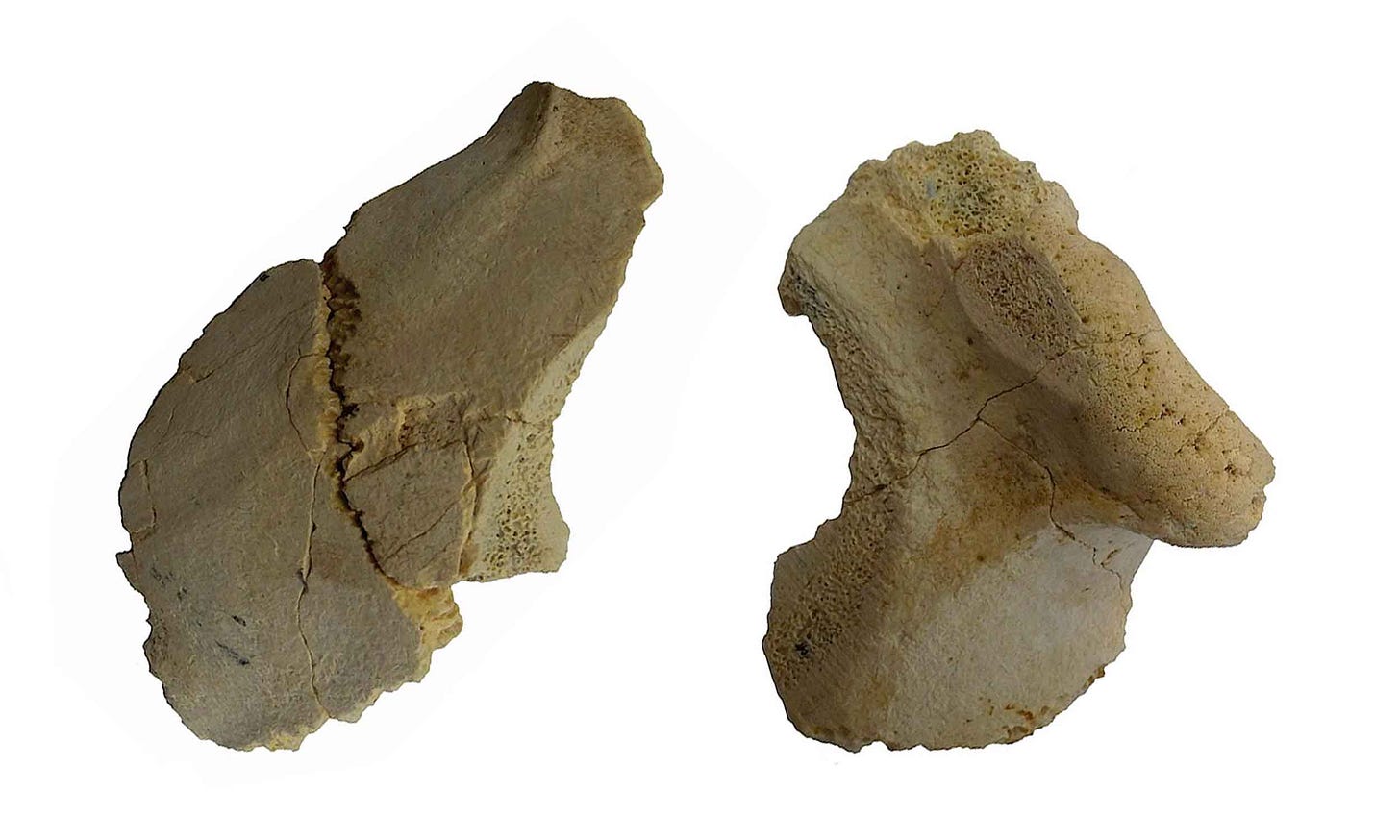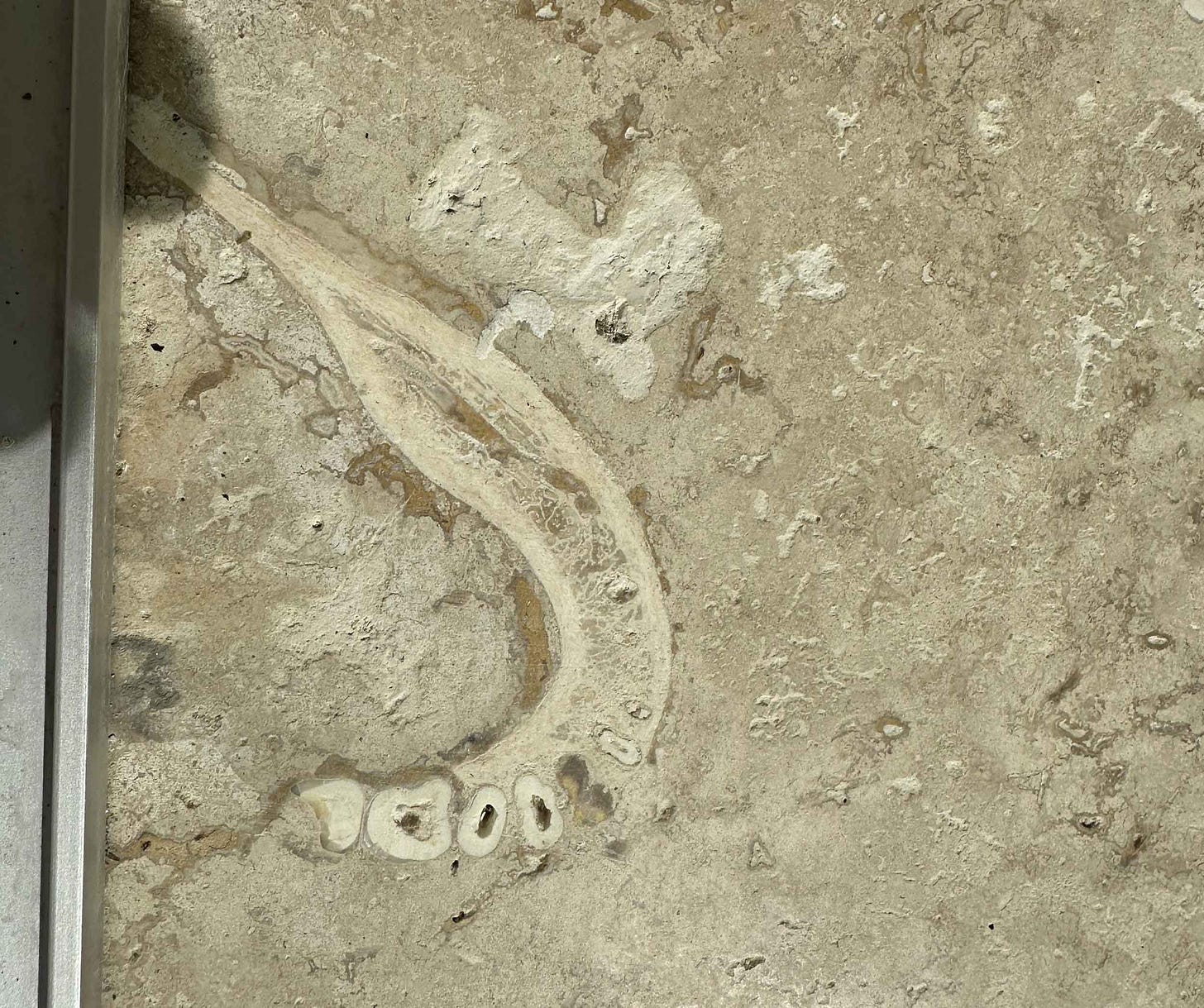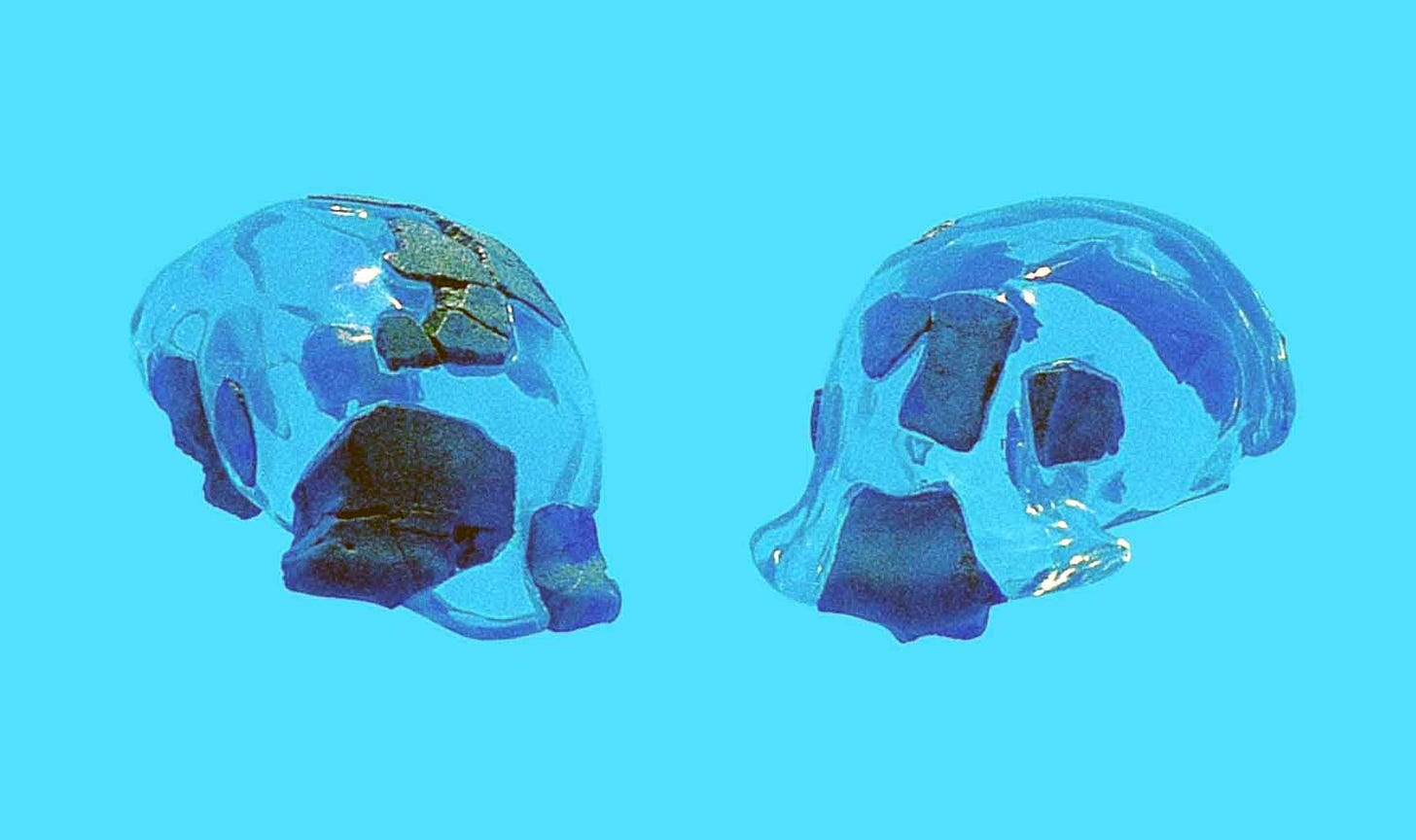How many bathrooms have Neanderthals in the tile?
A Reddit poster finds an ancient jaw in his parents' new travertine. It may be more common than most people imagine.

Gretchen shared with me an absolutely fascinating post on Reddit today: “Found a mandible in the travertin floor at my parents house”. The poster is a dentist and visited his parents house to see the new travertine they installed. It's no surprise that he recognized something right away:

A section cut at a slight angle through a very humanlike jaw! I'm working in South Africa currently and I showed the image to some of our fossil preparation specialists today. Everybody agreed it is pretty cool!
The Reddit user who posted the story (Kidipadeli75) has followed up with some updates over the course of the day. The travertine was sourced in Turkey, and a close search of some of the other installed panels revealed some other interesting possible fossils, although none are as strikingly identifiable as the mandible. A number of professionals have reached out to offer assistance and I have no doubt that they will be able to learn a lot about the ancient person whose jaw ended up in this rock.
This naturally raises a broader question: How many other people have installed travertine with hominin fossils inside?
Travertine is a limestone that forms near natural springs. Spring water that emerges from lime-rich bedrock often carries a high concentration of dissolved calcium carbonate. When the water evaporates or cools—especially near hot springs—this calcium carbonate precipitates as rock and may form very large deposits around the spring. Travertine has an interesting internal texture when polished, and often has color bands and inclusions of calcite crystals, which make it an appealing choice for decorative flooring or wall covering.
Travertine also commonly includes fossils. Many are fossil inclusions of algae, plants, and small animals—especially molluscs and crustaceans—that live within the spring water. Much larger animals may be found and humans are no exceptions: Several well-known hominin fossil discoveries are from travertine deposits. Most of these discoveries have happened because of quarrying of the travertine deposits for use in construction.
For example, the Steinrinne site is on a terrace of the Wipper River near Bilzingsleben, Germany. The site was quarried from the Middle Ages onward into the twentieth century. Naturalists took notice of the fossils there in the nineteenth century, and straight-tusked elephants, woolly rhinos, and macaques all occur in great numbers, dating to an interglacial period sometime between 470,000 and 280,000 years ago. Many of the archaeological discoveries at the site were made by Dietrich Mania starting in 1969. Excavations since then have identified stone tools and many animal bones with cutmarks from ancient humans who butchered them—even stone handaxes made from elephant bone.

Parts of at least two hominin skulls and a mandible were uncovered in the travertine during Mania's excavations. The remains were first studied by Emanuel Vlček, who created reconstructions of the two skulls. They have many similarities with Homo erectus, as Vlček emphasized, including the thick cranial bone, thick and pronounced browridges, and highly angled occipital bone at the back of the skull. Today's scientists, while recognizing these aspects, more often consider the skulls as representatives of an early Neandertal or related population, which sometimes is known as Homo heidelbergensis.
Another fossil human was discovered in an even more dramatic way. In 2002, Mehmet Cihat Alçiçek was examining fossils recovered from travertine quarries of the Denizli Basin of southwestern Turkey when he identified a cross-section of a hominin cranium. The upper and lower surfaces where the fossil was cut are well preserved, suggesting that more of the skull had likely been present but no more was found. Dating of the travertine by Anne-Marie Lebatard and collaborators in 2014 suggests that the individual lived sometime between 1.6 million and 1.2 million years ago. The quarry that produced the fossil is near the village of Kocabaş, and that is the name by which the fossil has been designated.
“Given the nature of its discovery in a factory workshop, the hominin was unfortunately reduced to a standard rough-cut tile thickness of about 35 mm…” —John Kappelman and coworkers
The shape of this portion of the Kocabaş skull and its thick supraorbital torus have led most researchers to identify it as a Homo erectus individual. The endocranial surface of the frontal bone has granular impressions that were initially suggested as possible evidence of tuberculosis infection. While this is still possible, later work suggested that these impressions may rather reflect a common condition in which the cranial bone remodels due to arachnoid cell growth.
The Kocabaş skull points to the most obvious question that Reddit posters shared: Why didn't anybody notice a human jaw in the travertine before it was installed in someone's house?
This question isn't so hard to answer. Quarries rough-cut travertine and other decorative stone into large panels, doing basic quality checks for gaps and large defects on the rough stone before polishing. Small defects and inclusions are the reason why people want travertine in the first place, so they don't merit special attention. Consumers who buy travertine usually browse samples in a showroom to choose the type of rock, and they don't see the actual panels or tile until installation. Tile or panels that are polished by machine and stacked in a workshop or factory for shipping are handled pretty quickly.
What this means is that there may be lots more hominin bones in people's floors and showers.
Most will be hard to recognize. Random cross-sections of hominin bones are tough to make out from other kinds of fossils without a lot of training. Noticing a fossil is not so hard, but I have to say that I've often been surprised at what the rest of a fossil looks like after skilled preparators painstakingly extract it from the surrounding rock. The ways that either nature or a masonry saw may slice a fossil don't correspond to an anatomy book, and a cross-section through part of a bone doesn't usually resemble an X-ray image of a whole bone.
Believe me, anthropologists don't want to hear about every blob of bone in your tile. Bones from other kinds of animals massively outnumber hominin bones in large travertine deposits. Most tile and panels are cut thin enough that if a fossil not clearly identifiable from its exposed surface, the thin portion beneath the surface is not likely to identify it either. Nobody wants to drill into your shower wall on a wild goose chase.
But certainly somebody has more pieces of the mandible from the Reddit post, and more pieces of the Kocabaş individual are probably installed in hotel bathrooms all across Europe. If you take another look at your shower wall and suspect an ancient human is looking back at you, it might actually be one.
The broader point is that a lot of the archaeological and fossil record has emerged as a result of industrial processes and construction. Paleontologists are in an uneasy symbiosis with quarries. The work of the rockcutters exposes underground sections that scientists would never know for centuries, yet at the same time it destroys evidence that might be recovered with enough paleontological labor. It helps for workers to have some training to notice potentially interesting finds as they encounter them, and for paleontologists and archaeologists to be engaged with the industries and construction projects that often encounter ancient remains.
And if you do happen find a jawbone in your bathroom, my suggestion is first to contact the local authorities. Sure, a fossil in travertine likely comes from hundreds of thousands of years ago. It isn't a crime scene. But depending on your state or nation of residence, laws governing discovery of human remains on your property may be complicated and having the paperwork in order with the police, sheriff, or coroner is the first step for most investigations.
For myself, I'll be following the Reddit story with interest—I expect there will be many twists and turns in the story of this jawbone. With some teeth preserved and abundant surrounding rock, I expect that specialists will be able to learn a great deal about the life of this individual and when he or she lived.
Assuming, that is, the parents wouldn't rather keep it where it is installed now.
Notes: I've included some references for the Kocabaş and Bilzingsleben discoveries below. There is much more to say about both of them. Investigation of Middle Pleistocene and earlier travertine deposits is one of the most promising avenues to understand ancient environments in which human ancestors and relatives lived.
References
Kappelman, J., Alçiçek, M. C., Kazancı, N., Schultz, M., Özkul, M., & Şen, Ş. (2008). First Homo erectus from Turkey and implications for migrations into temperate Eurasia. American Journal of Physical Anthropology, 135(1), 110–116. https://doi.org/10.1002/ajpa.20739
Lebatard, A.-E., Alçiçek, M. C., Rochette, P., Khatib, S., Vialet, A., Boulbes, N., Bourlès, D. L., Demory, F., Guipert, G., Mayda, S., Titov, V. V., Vidal, L., & de Lumley, H. (2014). Dating the Homo erectus bearing travertine from Kocabaş (Denizli, Turkey) at at least 1.1 Ma. Earth and Planetary Science Letters, 390, 8–18. https://doi.org/10.1016/j.epsl.2013.12.031
Vialet, A., Guipert, G., & Cihat Alçiçek, M. (2012). Homo erectus found still further west: Reconstruction of the Kocabaş cranium (Denizli, Turkey). Comptes Rendus Palevol, 11(2), 89–95. https://doi.org/10.1016/j.crpv.2011.06.005
Vlček, E. (1978). A new discovery of Homo erectus in central Europe. Journal of Human Evolution, 7(3), 239–251. https://doi.org/10.1016/S0047-2484(78)80115-8
Vlcek, E., Mania, D., & Mania, U. (2000). A new find of a Middle Pleistocene mandible from Bilzingsleben, Germany. Naturwissenschaften, 87(6), 264–265. https://doi.org/10.1007/s001140050717

